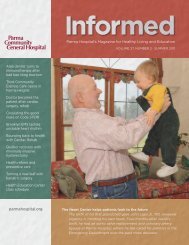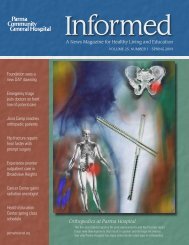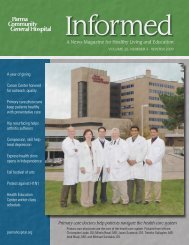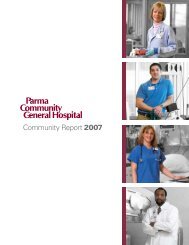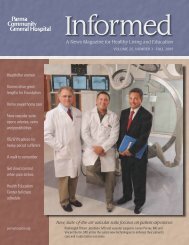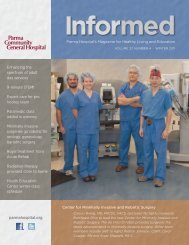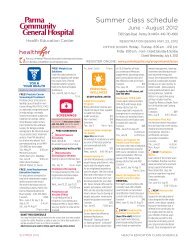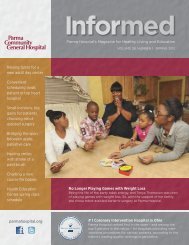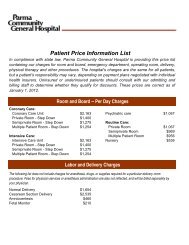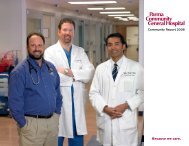Informed Magazine - Winter 2009.pdf - Parma Community General ...
Informed Magazine - Winter 2009.pdf - Parma Community General ...
Informed Magazine - Winter 2009.pdf - Parma Community General ...
Create successful ePaper yourself
Turn your PDF publications into a flip-book with our unique Google optimized e-Paper software.
care to keep patients well<br />
family, and watch how parents and kids<br />
interact, you develop a rapport and a<br />
comfort level with each family member,”<br />
said Dr. Saridakis.<br />
Selecting specialists<br />
PCPs also help guide their patients<br />
through the health care system by<br />
selecting specialists to manage aspects<br />
of their care, such as cardiology or<br />
orthopedics, when necessary.<br />
Each PCP has specialists they prefer<br />
to handle the care of their patients.<br />
“You want the A-team on your case<br />
at all times,” said Dr. Loyke, noting that<br />
he looks for clinical excellence as well<br />
as compassionate care and an ability to<br />
communicate with other physicians in<br />
coordinating care for the benefit of the<br />
patient.<br />
Patients have a major advantage<br />
when they see physicians with privileges<br />
at a community hospital: doctors<br />
are better able to keep in touch with<br />
each other and follow through on the<br />
patient’s care, said Dr. Saridakis.<br />
A primary care physician can coordinate<br />
the care in complex cases, especially<br />
for older patients. For example,<br />
the Acute Rehabilitation Center provides<br />
additional therapies to strengthen<br />
patients before discharge. Keeping<br />
patients onsite allows their PCPs to follow<br />
their care more closely, said William<br />
Crowe, MD.<br />
For example, an 85-year-old<br />
woman who lives independently but<br />
breaks a hip or develops pneumonia has<br />
a better chance of returning home again<br />
with the aid of rehabilitation onsite.<br />
“A finely balanced situation can be<br />
lost,” Dr. Crowe said. “Inpatient rehabilitation<br />
here at <strong>Parma</strong> Hospital gives<br />
us more breathing room to help patients<br />
return home rather than going to a<br />
nursing home.”<br />
Nurse practitioners are<br />
registered nurses with<br />
additional training who<br />
complement primary<br />
care physicians, seeing<br />
patients in the office<br />
and in some cases at<br />
the hospital. Nurse practitioner<br />
Donna Vale, left,<br />
is a certified diabetic<br />
educator who serves as<br />
a resource for doctors<br />
like Jennifer Wurst, MD.<br />
These advanced practice<br />
nurses are primary<br />
health care providers,<br />
with emphasis on teaching<br />
and prevention.<br />
Minimize trips to the Emergency Room<br />
Having a regular primary care physician<br />
(PCP) can eliminate unnecessary<br />
and costly tests that may be ordered in an<br />
ER when a physician is less familiar with<br />
a patient, says Timothy Gallagher, MD.<br />
It can also save patients time. Most<br />
PCPs are available in the office daily for<br />
sick visits as well as well visits.<br />
“A lot of time people are seen in the<br />
ER for something that maybe five days<br />
sooner could have been taken care of in<br />
the office and not required an ER visit,”<br />
said Jason Sustersic, DO. “The theory of<br />
primary care is: if someone calls in sick,<br />
they should be able to be seen that day,<br />
or at least the next day.”<br />
Persistent coughs, back pain and<br />
sinus issues may better be handled in<br />
the physician’s office, while symptoms<br />
such as active wheezing, shortness of<br />
breath or dehydration can better be<br />
served in a visit to the ER for immediate<br />
care, Dr. Sustersic said.<br />
“We are going to try to keep you out<br />
of the hospital and out of the ER,” Dr.<br />
Sustersic said.<br />
Managing complex<br />
situations for elderly<br />
The global perspective offered by a primary care<br />
physician becomes even more critical for older<br />
patients.<br />
William Crowe, MD,<br />
an internal medicine<br />
physician with a special<br />
certification in geriatrics,<br />
notes that many patients<br />
may take a dozen<br />
different medications,<br />
covering half a dozen<br />
William Crowe, MD diagnoses.<br />
Dr. Crowe recalled a patient he saw in the<br />
office who was on multiple medications for<br />
diabetes and high blood pressure. But the man<br />
also suffered from lower extremity edema,<br />
severe swelling caused by a build-up of fluids<br />
in the skin and organs. Two of the medicines<br />
he had been prescribed by other doctors were<br />
making his edema worse. Dr. Crowe switched<br />
his medicines and the man shed 30 pounds of<br />
water weight.<br />
“We review the medication record every time<br />
a new medicine is added, or a new problem<br />
develops,” Dr. Crowe said. “That drill goes on<br />
again and again, and it should.”<br />
Geriatric care actually begins around age 75,<br />
Dr. Crowe explains, yet it’s the physiologic age<br />
rather than the chronological age of the patient<br />
that really matters. In addition to reviewing a<br />
patient’s medical history with each visit, PCPs<br />
focus on preventative issues such as screenings.<br />
In older patients, the issue becomes when to<br />
cease screenings.<br />
By the age of 75 or 80, many doctors, at the recommendation<br />
of health agencies, no longer push<br />
for screenings. One exception is osteoporosis.<br />
“You can intervene even in the very old for<br />
osteoporosis,” Dr. Crowe said.<br />
PCPs – especially those at <strong>Parma</strong> Hospital who<br />
manage their patients even while they’re in the<br />
hospital – offer a continuity of care that benefits<br />
patients, Dr. Crowe said.<br />
And for older patients eventually facing end-oflife<br />
issues, the relationship formed with a PCP<br />
can be comforting.<br />
“All you need to do is see the looks on their<br />
faces,” Dr. Crowe said. “They’re relieved and<br />
happy to see me. It truly makes their care more<br />
efficient, to know that I’m there for them every<br />
day. We don’t have as many problems with endof-life<br />
care, because people know us.<br />
“If I’ve been their doctor, they trust me and I<br />
am straightforward with them. It’s so much<br />
easier to go through this with them if we have a<br />
relationship.”<br />
<strong>Winter</strong> 2009 <strong>Informed</strong> 5



